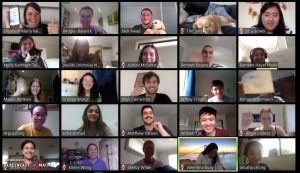Online learning is often depicted as impersonal – the lack of ‘face-to-face’ interaction can make students (and teachers) feel isolated in the process of learning. While it is true that in moving to teach online we have lost the weekly ritual of gathering in shared physical spaces, it would be a mistake to imagine that this makes the learning and teaching less intimate. In the new Zoom classroom, cats walk across computers, parents bicker in the background, children walk across the edge of the couch you’re sitting on and then thump to the ground – off-camera, but audible. We are asked to bring students into our living spaces, and students are asked to bring us – and each other – into theirs.

We have long thought that one of the duties as a teacher is to offer hospitality – to welcome students into the physical and epistemological spaces we inhabit at the university (Mann, 2001). But in these strange times, pedagogical hospitality becomes much more obviously reciprocal. The warmth and welcome we are able to offer in those online spaces depends as much on students’ ability and willingness to share their spaces with us as it does our skill in sharing our spaces with them. Pre-class small talk about the length of the walk between tutorial rooms might be replaced by small talk about a poster, a houseplant or, on one memorable occasion, a boat that might be only just visible in the background. Just as frequently, class can begin with black squares and silence if students don’t, or can’t, switch on their cameras.
Deciding whether or not to be visible in that way is a complex one for many. Some students have privacy concerns, some students don’t want to risk having their faces recorded, and some students simply feel uncomfortable giving strangers that kind of insight into their daily life. For others, ‘cameras on’ presents a more mundane, technological barrier – too little bandwidth, or broken or glitching tech. And yet the capacity to see each others’ faces, and to have moments of idle chatter, is a big part of what helps students and teachers feel connected to learning as a community activity, rather than a solo enterprise.
Perhaps in some classes, the capacity for students and staff to connect in a warm, human way feels like a valuable, but secondary, function of the learning environment. In an Industry and Community Project Unit (ICPU), however, it is essential. ICPUs require students from throughout the University to work collaboratively to develop an interdisciplinary solution – often a sophisticated set of recommendations – to a complex problem proposed by an industry or community partner organization. Each team is comprised of 5 or 6 students in their third year of academic study, with group composition reflecting the diversity of university undergraduates. The challenge for an ICPU project supervisor is to get to know students and, perhaps even more importantly, facilitate opportunities for students to get to know each other. When the whole learning experience revolves around the fruitful collaboration of a group of perfect strangers, ‘getting to know each other’ is essential to the educational enterprise.
For better or worse, our great pivot to remote learning in semester 1 took place once most of us had met our students, and our students had met each other. In the first two or three weeks of semester 1, we established rapport with students, learned about their disciplines and introduced students to their fellow group members. In short, the work of establishing a hospitable learning environment was well underway by the time we moved online – our challenge was simply sustaining it.
Conversely, from the beginning of Semester 2 (August 2020), many teachers across the university started their teaching online for the first time. This can be a scary prospect. In a somewhat unusual situation, many Ppoject supervisors of ICPUs spent the July session teaching intensives, experiencing a little earlier than most what Semester 2 teachers have now encountered. In partnership with KPMG, Coles, WPP, TAD and others, students worked remotely from the very first day of those July classes. Laura was one of those teachers, Jess was not. In the following discussion, we explore some of the techniques Laura used to engage students in the creation of a hospitable learning environment.
Jess: Take us through it from the start. What were your very first forms of contact with the students? Did that differ from an ordinary semester?
Laura: In an ordinary semester, I would reach out to students before the start of class with a welcome message in which I would describe the unit of study and encourage them to explore the Canvas site. The real task of making the class hospitable would take place during our first face-to-face lesson which is when we’d introduce ourselves. I took a wildly different approach during this fully online intensive semester. This time, the goal of my welcome video was to introduce myself, the unit and emphasise the value of being open and willing to participate. This video was linked to a remote learning module that I developed in which I aimed to reframe the experience of learning online as an opportunity to develop skills in remote collaboration. I described the advantages and challenges of learning remotely and described how, with students’ help, we would work to manage those together. I listed feeling disconnected as one of the biggest challenges we’d face and that, with their consent and cooperation, we’d try to keep our cameras on during discussions. To chunk the modules and encourage engagement, I developed a crossword puzzle, used a Menti poll to gather student feedback and developed a Padlet where students were asked to upload a photo, introduce themselves and tell me what they do in their downtime. I enjoyed building our learning community this way so much that I’m unsure I’ll go back!
I aimed to reframe the experience of learning online as an opportunity to develop skills in remote collaboration…
Jess: I imagine students (and teachers) completing an intensive – and especially one that’s entirely online – can experience a fair bit of project fatigue. Do you have any ideas about how we can help students re-engage with the class in the face of that fatigue?
Laura: Some of the most fun I had during the intensive was inventing new ways of keeping students engaged. Rather than pretending we weren’t all in our homes, I leaned in to that experience. In fact, it seemed important to acknowledge the joys and miseries of working from home. Students were encouraged to bring their pets to class, dress up in costume (though we ran out of time and energy for that one) and play the musical instruments they had lying around. My favourite way of connecting, though, was through “supper club.” In the introductory Padlet, many students listed cooking and eating as a favourite pastime. On a shared Padlet and through discussion over the course of the semester, we would share what we cooked the previous evening and students would circulate recipes, including by emailing me recipe challenges. It was like a Masterchef challenge, though with far more average results. Next semester, I might try to play a game of “who can pretend their camera is frozen while the lecturer asks a question” the best and, for those students unwilling to engage with their cameras on, establish a class doodling board.
The most important thing is for students to know that we’re interested in their engagement, however they may choose to do this.

Jess: So many of these ideas depend on students having the willingness (and capacity) to share in these ways. How can we balance our desire to create these fun experiences with a desire to respect students’ different preferences and circumstances?
Laura: It strikes me that the most we can do is to provide a rationale for students’ involvement and develop options for students who may be less willing to turn on their videos, whatever their reasons. Encouraging creative Zoom backgrounds for students unwilling to disclose their learning environment is one option while developing a sustainable backchannel is another: Menti, Socrative, Google Forms and Docs, AnswerGarden, and Padlet all provided opportunities for student engagement during the intensive. Oftentimes, as teachers, we want feedback on how the class is progressing and in these contexts, simply asking students to give us a thumbs up, either virtually using Zoom or an actual thumbs up to camera, can do the trick. The most important thing is for students to know that we’re interested in their engagement, however they may choose to do this. Research shows that taking an interest in your students’ experience of your class and creating a hospitable environment can be the difference between thriving and being left behind.
Want to know more about engaging your students online?
For more information on engaging your students online (in an inclusive and respectful way), we recommend:
- Coming along to one of the Modular Professional Learning Framework (MPLF) sessions (available to all University of Sydney staff):
- Visiting the COVID Canvas site, for an overview of resources to support teaching off-campus.
- Engaging with the recordings and resources compiled from the Teaching Well and Supporting Students During COVID-19 symposium





